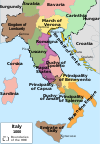Vitiges
- View a machine-translated version of the Italian article.
- Machine translation, like DeepL or Google Translate, is a useful starting point for translations, but translators must revise errors as necessary and confirm that the translation is accurate, rather than simply copy-pasting machine-translated text into the English Wikipedia.
- Consider adding a topic to this template: there are already 3,026 articles in the main category, and specifying
|topic=will aid in categorization. - Do not translate text that appears unreliable or low-quality. If possible, verify the text with references provided in the foreign-language article.
- You must provide copyright attribution in the edit summary accompanying your translation by providing an interlanguage link to the source of your translation. A model attribution edit summary is
Content in this edit is translated from the existing Italian Wikipedia article at [[:it:Vitige]]; see its history for attribution. - You may also add the template
{{Translated|it|Vitige}}to the talk page. - For more guidance, see Wikipedia:Translation.
| Vitiges | |
|---|---|
| King of the Ostrogoths | |
| Reign | 536 – 540 |
| Predecessor | Theodahad |
| Successor | Ildibad |
| Born | ≥500 |
| Died | 542 |
| Spouse | Matasuntha |


Vitiges (also known as Vitigis, Witiges or Wittigis) (died 542) was king of Ostrogothic Italy from 536 to 540.[1] He succeeded to the throne of Italy in the early stages of the Gothic War of 535–554, as Belisarius had quickly captured Sicily the previous year and was in southern Italy at the head of the forces of Justinian I, the Eastern Roman Emperor.
Vitiges was the husband of Queen Amalasuntha's only surviving child, Matasuntha;[2] therefore, his royal legitimacy was based on this marriage.[3] The panegyric upon the wedding in 536 was delivered by Cassiodorus, the praetorian prefect, and survives, a traditionally Roman form of rhetoric that set the Gothic dynasty in a flatteringly Roman light. Soon after he was made king, Vitiges had his predecessor Theodahad murdered.[4] Theodahad had enraged the Goths because he failed to send any assistance to Naples when it was besieged by the Byzantines, led by Belisarius.
Belisarius took both Vitiges and Matasuntha captive to Constantinople,[5] and Vitiges died there in 542, without any children. Procopius described parallels among the deposition of Vitiges and Croesus, king of Lydia.[3] After his death, Matasuntha married the patrician Germanus Justinus, a cousin of Justinian I through his uncle Justin I.[6]
In fiction
Vitiges appears as a character in the time travel novel Lest Darkness Fall, by L. Sprague de Camp. He is portrayed by Florin Piersic in the 1968 film Kampf um Rom.
See also
References
- ^ Edward Gibbon; Henry Hart Milman (1880). The History of the Decline and Fall of the Roman Empire. Harper & brothers. p. 271.
- ^ Julius von Pflugk-Harttung; John Henry Wright (1905). The great migrations. Lea brothers & company. p. 374.
- ^ a b Kovács, Tamás (2019). "Procopius's Sibyl – The Fall of Vitigis and the Ostrogoths" (PDF). Graeco-Latina Brunensia. 24 (2): 113–124. doi:10.5817/GLB2019-2-8.
{{cite journal}}: CS1 maint: date and year (link) - ^ John H. Rosser (2012). Historical Dictionary of Byzantium. Scarecrow Press. p. 458. ISBN 978-0-8108-7567-8.
- ^ John Stevens Cabot Abbott; Wilfred C. Lay (1900). Italy. P. F. Collier. p. 424.
- ^ John R. Martindale (1980). The Prosopography of the Later Roman Empire: Volume II, AD 395–527. Cambridge University Press. p. 505. ISBN 0-521-20159-4.
| Regnal titles | ||
|---|---|---|
| Preceded by | King of the Ostrogoths 536–540 | Succeeded by |
- v
- t
- e
- Odoacer (476–493)

- Theodoric (493–526)
- Athalaric (526–534)
- Theodahad (534–536)
- Vitiges (536–540)
- Ildibad (540–541)
- Eraric (541)
- Totila (541–552)
- Teia (552–553)
- Alboin (568–572)
- Cleph (572–574)
- Interregnum (574–584)
- Authari (584–590)
- Agilulf (590–616)
- Adaloald (616–626)
- Arioald (626–636)
- Rothari (636-652)
- Rodoald (652–653)
- Aripert I (653–661)
- Godepert (661–662)
- Perctarit (661–662)
- Grimoald (662–671)
- Garibald (671)
- Perctarit (671–688)
- Cunipert (688–689)
- Alahis (689)
- Cunipert (689–700)
- Liutpert (700–702)
- Raginpert (701)
- Aripert II (702–712)
- Ansprand (712)
- Liutprand (712–744)
- Hildeprand (744)
- Ratchis (744–749)
- Aistulf (749–756)
- Desiderius (756–774)
- Charlemagne (774–814)
- Pepin (781–810)
- Bernard (810–818)
- Lothair I (818–855)
- Louis I (855–875)
- Charles II (875–877)
- Carloman (877–879)
- Charles III (879–887)
- Arnulf (896–899)
- Ratold (896)
(title disputed 887–933)
- Unruochings: Berengar I (887–924)
- Guideschi: Guy (889–894)
- Lambert (891–897)
- Welfs: Rudolph (922–933)
- Bosonids: Louis II (900–905)
- Hugh (926–947)
- Lothair II (945–950)
- Anscarids: Berengar II (950–963)
- Adalbert (950–963)
the Holy Roman Empire
(962–1556)
- Otto I (962–973)
- Otto II (980–983)
- Otto III (996–1002)
- Arduin I (1002–1014)
- Henry II (1004–1024)
- Conrad II (1026–1039)
- Henry III (1039–1056)
- Henry IV (1056–1105)
- Conrad II (1093–1101)
- Henry V (1106–1125)
- Lothair III (or II) (1125–1137)
- Conrad III (1138–1152)
- Frederick I (1154–1186)
- Henry VI (1186–1197)
- Otto IV (1209–1212)
- Frederick II (1212–1250)
- Henry VII (1311–1313)
- Louis IV (1327–1347)
- Charles IV (1355–1378)
- Sigismund (1431–1437)
- Frederick III (1452–1493)
- Charles V (1530–1556)
  | This Italian history article is a stub. You can help Wikipedia by expanding it. |
- v
- t
- e











